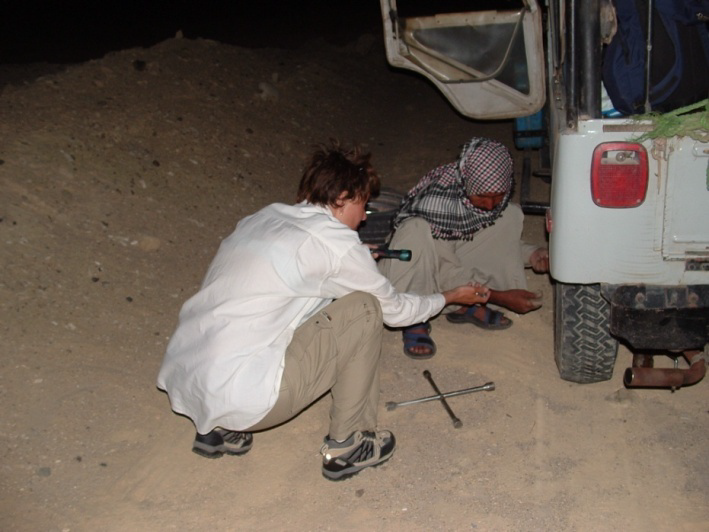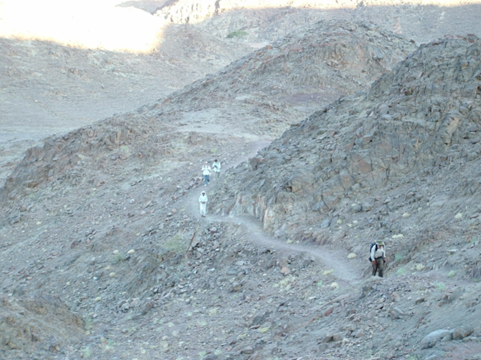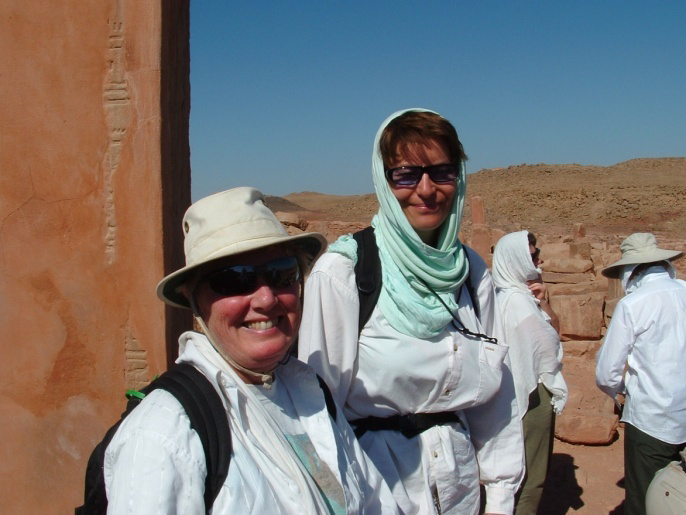Canadian Egyptologist - Rexine Hummel
Part III - Sinai digs and Serabit el-Khadim
Rexine was part of the Eastern Frontier Archaeological Project, Tell el-Borg, in the North Sinai, with director, James Hoffmeier for 8 seasons (2000, 01, 02, 04, 05, 06, 07 and 08),[1] and also on the El-Markha Plain Site 346, and Ras Budran in South Sinai, with director Greg Mumford for 2002, 2004, and 2008.[2]
Tell el-Borg
Rexine is thinking about these digs, and we might circle back to them.
South Sinai
It was on the first two seasons in South Sinai (2002 and 2004) that Rexine and I first worked together. She was lively and lovely. Some of my fondest memories of her are when she would get in her ‘floaty’ and swim about at Moon Beach. We worked close together in drawing and identifying the pottery.
The team at El-Markha Plain - Site 346 and 345 (Ras Budran) those two seasons (2002 & 2004) consisted of the following:
Dr. Greg Mumford (project director), Mustafa Rezk (Supreme Council of Antiquities Inspector), Laurence Pavlish (geoarchaeologist), Rexine Hummel (ceramicist), Patrick Carstens (photographer), Monica Bontty (registrar), Shakira Christodoulou (artist-registrar), and site supervisors Debborah Donnelly, Christopher Gilbert, Zoe McQuinn and Sarah Parcak.[3]
The following two stories are shared here in Rexine’s own words.
My Favourite Stories
by Rexine Hummel
Mountain Climbing in the Sinai [4]
It is 2004, 1 am a 67 year old widow with both a heart and a lung condition and probably should not be on an archaeological dig in the Egyptian Sinai desert in July when the temperature rises to over 50 degrees (Celsius) in the afternoon. The crew is buzzing with excitement over plans for the next day, our day off, a trip inland to climb the mountain called Serabit el-Khadim. It is a site, famous for its ancient turquoise and copper mines. Scholars are also attracted there in order to study the abundant graffiti and ancient inscriptions which are carved on the rock faces on the many paths ascending the mountain. Crowning the site is a temple to Hathor, the goddess of music, dancing and turquoise.
A vehicle must be rented to take us the 75 or so miles from our air-conditioned hotel on the Red Sea. We must leave around 5 a.m. in order to get there and start the climb by 7:30 am before the sun hits the east side of the mountain. Water and snacks are prepared.
The big subject of discussion is whether Madam Rexine should even attempt this. The no votes were largely on the side of the Egyptian inspectors and even the director of the dig. Although I wanted desperately to go I realized I could ruin everyone’s trip if something happened to me or I could not make the summit.
One of my colleagues, Debra (Debborah) Donnelly stepped forward and said that I must go and she would personally take care of me, walk every step with me and carry my water for me. Deb, herself had left a ten year career in the Canadian navy as a captain. I would never get another chance. I said I would go. Eyeballs rolled.
5 am found us scrambling into a pickup truck and soon we were travelling down the highway towards the cutoff into the desert. It is pitch black out. Desert driving is more difficult in the dark and we depended on the driver completely to find the trail in the sand.
Flat tires are common in Egypt and soon we had one.
Debra jumped out to help.
After a seemingly endless ride across the sand and rocks we reached our destination and disembarked.
We assembled our knapsacks and began to climb, anxious to get to the top before it became unbearably hot. The mountain is 850 meters above sea level.
The scenery is spectacular.
We passed wind carved rock formations on the path.
Trudge, trudge, trudge; true to her word Debbie stayed with me every step and gave me frequent sips of water. We brought up the rear. Patrick Carstens is at the front in the photo (below).
Climbing the mountain.
Patrick is way ahead of us bottom right.
A guard in a white galabiyya follows.
Behind him is Rexine slowly walking up with Debbie behind carrying water and helping the old lady every step.
After what seemed like hours we reached a narrow ledge that looked out over the valley on one side and on the mountain side there was a perpendicular wall about eight feet tall and covered with inscriptions . Our way forward was blocked and I was shocked and frightened when I was told that I was supposed to climb up this wall using only a few toe and finger holes. There was no alternative. I had to climb this wall. With Debbie pushing from below and directions for my feet and hands shouted out by colleagues above, I managed to crawl up lizard-like and landed sprawled out on the ledge above.
Landing area above wall. The guard is standing at the edge.
Triumphal arrival at the Hathor Temple by Rexine and Debbie.
We wandered through the ruins of the temple. We joined the rest of the team exploring the ancient mines and took pictures of the large hieroglyphic inscription that was located at the entrance of one of the mines.
It was noon and very hot and soon time to go back down the mountain. The young team members walked quickly, examining many of the tunnels and ancient mines on the way. I kept up the pace but we soon came to the dreaded wall where we had to lower our bodies over the edge and hope that our feet felt holes in the stone. I was terrified of falling but luckily made it to the ledge below. I began to feel woozy and had to sit down. The guards and inspector had that “told-you-so look” on their faces. I was embarrassed but I asked Debbie to put cold water on the back of my neck and I recovered quickly. We all had a little rest and then we continued down the mountain and back to the truck. A very successful day for an old lady…
Back at our hotel I tried to recreate the day’s event in my mind. What a day! I had made it to the top of a fairly high mountain with some serious and dangerous obstacles on the way. I was happy that I had been brave enough to attempt this challenge and eager to tell my elderly friends back home what they were missing.
Falling Off a Camel[5]
For some unknown reason I seem to be addicted to camels. I have a camel collection and shirts with camel motifs. I also have many photos of myself on camels since I took every opportunity that presented itself in Egypt to ride one. Greg Mumford and his wife Sarah Parcak, are dear friends who were always extremely kind to me. My June birthday often occurred while I was on their digs. On two occasions Greg arranged for a camel to be tied up at my pottery table when I arrived as a surprise. I think the camel was surprised as well. I do have a story of falling off a camel. I only have these two pics of the camel that I fell off of. I wrote about it in my dig diary that was published in the SSEA Newsletter of 2008.[6] It was edited by Lyn Green and she changed some of my words and made it sound better.
Excerpt from Rexine’s Dig Diaries[6] - June 20, 2008
“Yesterday was the nineteenth of June and I turned 71. I was dreading the date but as it turned out it was a spectacular day. The evening of the 18th we had a beer on the terrace of the resort while we watched the sunset and celebrated the ending of 70 years of an interesting life. The next day at work was typical with pottery coming and lots of labelling and bagging of pot sherds and finds.
Around 12 noon I looked up and saw a tall, gorgeous camel with a beautiful hand woven rug on its back, standing close to my tent.
Greg came down from the mound and told me that she was my birthday camel and I must take a ride on her.
These local camels are one person camels and she knew from the start that I smelled different and was not her owner. She eyed me up and down and gave one mighty gurgle-y growl. Her owner sweet-talked her into sitting down so that I could get on to her back. At 71, getting my leg up that high and then trying to follow my leg up there was not an easy task. With a lot of jiggling, oomphing, and grunting I managed to get myself up and then we went through the procedure of being thrown violently forward and then backward while the camel got up. The handholds appeared to be cut from thick tree branches and were quite high but easy to hold on to. Off we went around the fort and down toward the Red Sea. We couldn’t go all the way since the camel hated salt water and wouldn’t go near it, but I didn’t care.
I was happy to go wherever she wanted to go. She would stop at every bush and chow down. She obviously was in control.
After a stroll around the fort we came back and prepared for dismount. Unfortunately, just as she lowered her front half the saddle came undone and began pushing me down the camel’s neck head first. I got conked in the chest by the wooden hand hold — and then as the camel felt me sliding down her neck she countered by raising her head and we knocked heads. She let out a mighty indignant roar that brought a lot of people running to my rescue. They thought she was going to bite me. I continued to slide down until I landed on my shoulder on the ground with my foot caught up in the camel saddle right beside her head.
Someone helped me untangle my foot while I was upside down and then I was able to do a slow, arthritic scramble to my feet. It wasn’t the most glorious ending to a camel ride but it isn’t every day you get to fall off a camel. I thanked the camel driver and the camel. I limped away and did a bit more work, tidied up and got ready to leave. By this time the baby camel had arrived to join her mother. They galloped around a little and then Greg told me I could ride her across Viper Park to the van. I asked the driver if the saddle was on tight and we were off again. This time all went well and the baby camel strutted along beside us. The saddle stayed put when I had to dismount and I retained my dignity.
Even the camel seemed happy.”
Patrick Carstens, photographer at the South Sinai digs, shared the following photos and a short story about Rexine.
“Rexine Hummel and the Horned Viper (2004)
About 10 feet from Rexine’s pottery sorting location a Horned Viper was in the bush. I was also standing there when a Bedouin saw the snake. and started to swing wildly at the bush with a shovel, he eventually dislodged the snake and decapitated it. Then, other Bedouin gathered and took the decapitated head out into the desert and poured gasoline over the head, as the head was still alive, and they set it on fire, apparently part of their tradition....not sure if the Horned Viper would have attacked, but is was close enough.”
[1] Hummel, R. (2014) “A Report on the Ceramics Recovered from Tell El-Borg”, in Hoffmeier, J.K., ed. Excavations in North Sinai: Tell el-Borg. United States, Eisenbrauns. Ch 8 pp. 364-435.
J. K. Hoffmeier, T. W. Davis and R. Hummel (2016) “New Archaeological Evidence for Ancient Bedouin (Shasu) on Egypt’s Eastern Frontier at Tell el-Borg,” Ägypten und Levante 26 pp. 285–311.
Hoffmeier, James K., ed, (2019) Tell El-Borg II. Excavations in North Sinai. University Park, PA: Eisenbrauns. - online full text https://whitelevy.fas.harvard.edu/publications/tell-el-borg-ii-excavations-north-sinai
Mumford, G. and Hummel, RHM (2019) "Public Space at Tell el-Borg: Field II, Areas 1-3" pp. 21-135 in James K. Hoffmeier (ed.), 2019. Excavations in North Sinai: Tell el-Borg II. University Park: Eisenbrauns / The Pennsylvania State University Press.
[2] Mumford, G. (2015) “Explorations in El-Markha Plain, South Sinai: Preliminary Findings at Tell Markha (Site 346) and Elsewhere”, Journal of Ancient Egyptian Interconnections 7(1), 91-115. doi: https://doi.org/10.2458/azu_jaei_v07i1_mumford3
Mumford, G. (2003) Submitted Report: "The 2002 expedition to El-Markha Plain (South Sinai)" MARKHA PLAIN REPORT 2003 --Addendum: Later re-dated fort to Old Kingdom (4 pages; 4 figures)
[3] Mumford, G. (2005) Submitted Report: "Tell Ras Budran (Site 345): The 2002 and 2004 excavations in el-Markha Plain, South Sinai" Ras Budran Report 2005 (8 pages text; 14 figures).
[4] Full text copied from Hummel, R. (2022) Stories of My Life. Storyworth. Brackets are mine.
DD - Many Egyptologists never get the chance to visit Serabit el-Khadim. It is in a challenging location in the middle of the desert in the Sinai, and up a mountain. I knew that if Rexine didn’t go in 2004, she would probably never get another chance. Helping get her up the mountain made the excursion that much more special for me. When I saw her smile at the top I knew it was totally worth it. I’m so pleased that Rexine tells this story as her favourite. It is also one of mine. Rexine, thank you for your trust in me!
[5] Personal communication between Rexine and Debborah (Feb 24, 2025).
[6] Hummel, R. (2008) ‘A Day in the Life…’ - Personal Dig Diaries, in Boehmer, J., ed., Newsletter of the Society for the Study of Egyptian Antiquities, 2008-09 #1, pp. 5-7.
Other References:
Mumford, G. & Hummel, R., (2015) “Preliminary Findings at a Late Old Kingdom Fort in South Sinai, Including the Pottery, from the 2008 Season”, Journal of Ancient Egyptian Interconnections 7(1), 52-82. doi: https://doi.org/10.2458/azu_jaei_v07i1_mumford2
Hummel, R. (2010) "Ras Budran Ceramic Report 2008 season (June 1 - July 4)" RAS BUDRAN REPORT 2010 (11 pages, 4,198 words, 3 plates) - Unpublished report/article (extensively expanded and published with G. Mumford in JAEI 7.1 March 2015)





















